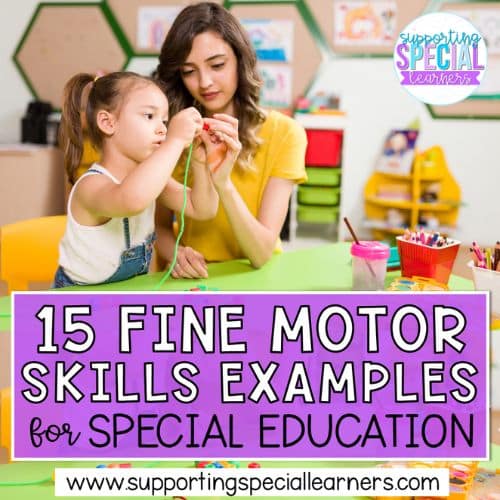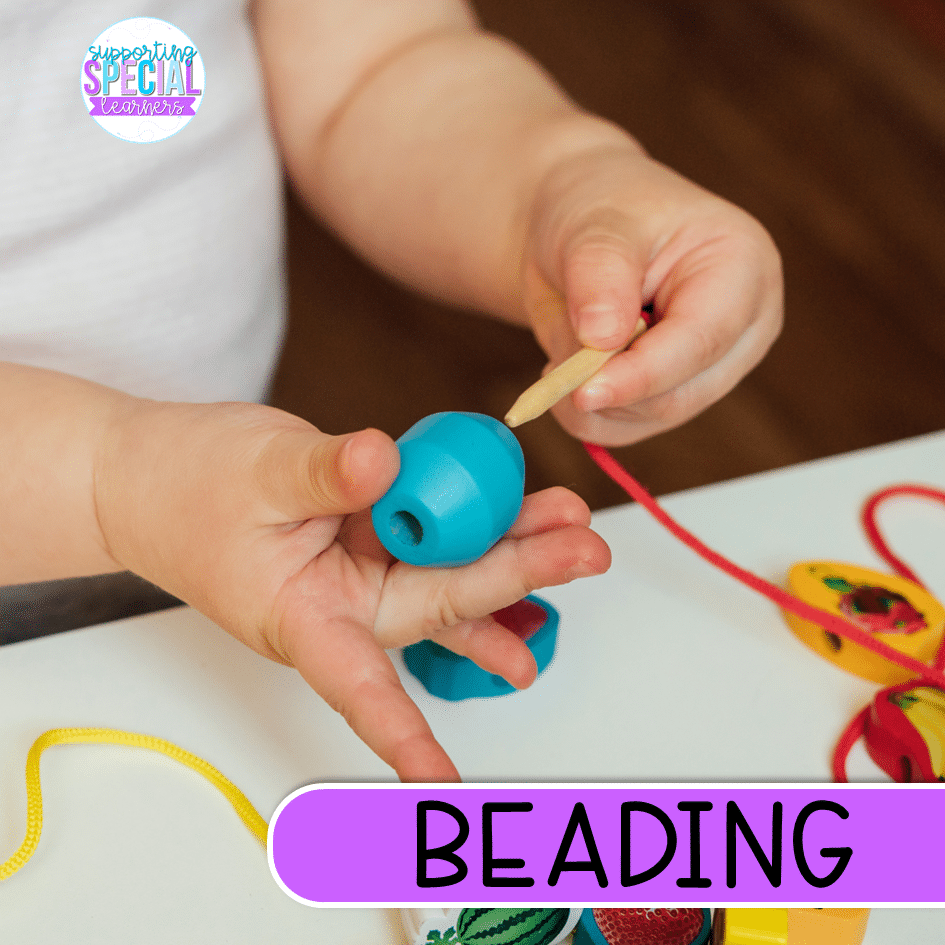Fine motor skills are essential for performing everyday tasks that require precise movements of the hands and fingers. For students in special education, particularly those with autism and related disabilities, developing these skills can be crucial for their independence and overall development. Here are 15 fine motor tasks that special education teachers can use to help students improve their fine motor skills.
Key Takeaways
- Playdough activities help improve hand strength and dexterity through squeezing, rolling, and manipulating the dough.
- Cutting with scissors enhances hand-eye coordination and fine motor control.
- Peeling and slicing fruits and vegetables can boost hand strength and fine motor skills.
- Tweezing tasks, such as picking up small objects, improve finger dexterity and hand-eye coordination.
- Using a fork and spoon is an important life skill that helps develop fine motor abilities and independence.
Playdough
Playdough is an excellent tool for enhancing fine motor skills in special education. Manipulating playdough helps build finger strength and dexterity, which are crucial for various daily tasks. There are numerous activities that can be done with playdough to keep students engaged and learning.
One effective method is using fine motor playdough mats: uppercase & lowercase letters and numbers. These mats not only enhance fine motor skills but also support alphabet and numeracy learning. They are ideal for PreK and kindergarten settings, special education, and diverse learning environments.
- Rolling snakes
- Flattening pancakes
- Rolling balls
Additionally, you can hide small objects like marbles, beads, or plastic animals in the playdough for students to find. This activity works brilliantly for improving manipulation skills and keeps the learning process fun and interactive.
Playdough activities can be tailored to individual student needs, making it a versatile and valuable resource in special education classrooms.
Cutting
Cutting with scissors is an excellent way to enhance hand-eye coordination and strengthen hand muscles. Before diving into complex projects, it’s crucial for students to become comfortable with using scissors and holding them correctly. Here are 5 different cutting activities to help build fine motor skills and practice using scissors:
- Cutting straight lines
- Cutting curvy lines
- Cutting zigzag lines
- Cutting out shapes
- Cutting for open-ended art projects
It’s important to balance helping students gain skills without causing frustration. Cutting for the sake of cutting, or for their own goals, is just as beneficial as cutting along a line or for a finished product.
Peeling and Slicing
Peeling and slicing are essential fine motor skills that can be both fun and educational for special education students. These activities help improve hand-eye coordination, dexterity, and precision.
Peeling
Peeling fruits like bananas or oranges is an engaging fine motor activity. It requires students to use their fingers to grasp and pull, enhancing their grip strength and control. This task can be made easier by starting with fruits that have looser skins.
Slicing
Slicing soft foods such as bananas or boiled eggs can be a safe and effective way to practice fine motor skills. Using child-safe knives, students can learn to apply the right amount of pressure and develop their hand strength. This activity also teaches them about safety and the importance of being careful with tools.
Peeling and slicing not only enhance motor skills but also offer tactile learning experiences, making them ideal for early learners in special education settings.
Tweezing
Tweezing activities are excellent for enhancing fine motor skills in special education. Tweezers are perfect for grabbing and counting small items like cotton balls, pom-poms, and beads. These activities not only improve hand-eye coordination but also strengthen finger dexterity.
- Picking up small objects
- Counting and sorting items
- Incorporating into math centers
Adding tweezers to a counting or math center can provide extra fine motor practice, promoting multidimensional learning experiences in an inclusive environment.
Using a Fork and Spoon
Using utensils is a crucial life skill that requires fine motor skills. Encourage students to hold their utensils correctly and to use them to feed themselves. This activity not only promotes independence but also enhances hand-eye coordination and finger dexterity.
Steps to Teach Using a Fork and Spoon
- Start with larger utensils: Begin with larger, easier-to-hold utensils to help students get comfortable.
- Demonstrate the correct grip: Show students how to hold the fork and spoon properly.
- Practice with different foods: Use a variety of foods to practice, starting with softer items.
- Gradually introduce smaller utensils: As students become more adept, switch to standard-sized utensils.
Using a fork and spoon can be integrated into daily routines, making it a practical and engaging fine motor activity.
Incorporating this skill into everyday activities can significantly improve a child’s ability to perform other tasks that require fine motor skills, such as using fine motor activity mats or engaging in other hands-on tools.
Handwriting
Handwriting is a crucial skill that hinges on fine motor control. Encouraging students to hold their pencils correctly and apply the right amount of pressure is essential. Fine motor activities like tracing upper and lowercase letters and numbers are designed for young learners in PreK and kindergarten to develop fine motor skills and reinforce literacy and numeracy concepts.
Tips for Improving Handwriting
- Proper Grip: Teach students to hold their pencils correctly.
- Pressure Control: Ensure they apply the right amount of pressure.
- Tracing Activities: Use tracing exercises for letters and numbers.
- Vertical Writing: Have students write on vertical surfaces like chalkboards to encourage proper grip and stability.
Handwriting practice is not just about forming letters; it’s about building the foundational skills that support literacy and numeracy.
Sorting Games
Sorting games help children develop fine motor skills through hands-on activities. This activity involves organizing items based on different attributes such as color, shape, or type. Start with larger toys like cars or Duplo blocks, and gradually move to smaller items such as pasta shapes, paper clips, or coins. This progression helps in refining their motor skills and cognitive abilities.
Shape sorter games are particularly effective. If you don’t have a shape sorter, you can create one by cutting a circular hole in the lid of a plastic pot and having children post small objects through it. This not only improves their fine motor skills but also their hand-eye coordination.
Once children have sorted their small objects, you can suggest additional activities using the sorted items. For example, they could make a necklace out of tube pasta or create a picture using glue and dried food items. This keeps them motivated and engaged while further developing their fine motor skills.
Buttoning
Buttoning is a fundamental fine motor activity that helps children develop independence and dexterity. When students are putting on their coats or jackets, this is a great time for them to build their fine motor skills. Encouraging them to do this on their own builds independence as well. Even though we know it’s so much quicker to do it for them, try to give them some time to try themselves. Get ready for lunch, recess, or dismissal 5 or 10 minutes early, so they have time to work on buttons and zippers on their own or with just a little help from the teacher.
Another way to strengthen fine motor muscles with buttons is with this “Button Count” activity, where students place the appropriate number of buttons on each gingerbread man.
Zipping
Zipping is a fundamental fine motor skill that children need to master for daily living activities. Practicing with buttons, zippers, and snaps helps children master dressing skills. This task not only enhances their dexterity but also boosts their independence.
To help students improve their zipping skills, consider the following tips:
- Provide jackets or bags with large, easy-to-grip zippers.
- Encourage students to practice zipping and unzipping in a controlled environment.
- Allow extra time for students to try zipping on their own before offering assistance.
Mastering zipping can significantly contribute to a child’s self-reliance and confidence in handling everyday tasks.
Lacing
Lacing activities are excellent for developing fine motor skills in children. They help improve hand-eye coordination and dexterity. Start with simple materials like pipe cleaners and colanders, allowing children to create patterns or bridges. As their skills improve, introduce laces with taped ends and use a hole punch to make threading holes in cards. For more advanced practice, use string, ribbon, or even thread on a needle for threading games. Children can also have fun re-lacing shoes or making necklaces with tube pasta or cut straws.
Beading
Beading is an excellent fine motor activity that requires children to hold beads and thread them onto a string. This activity not only enhances hand-eye coordination but also improves concentration. Stringing beads can be particularly beneficial for developing a child’s pincer grip and dexterity.
- Materials Needed:
- Beads of various sizes
- String, laces, or pipe cleaners
- Steps:
- Select beads and a string or lace.
- Thread the beads onto the string, one by one.
- Tie a knot at the end to secure the beads.
Beading activities can be easily integrated into patterning lessons or even math centers by adding number cards to the bead bucket. This makes the activity both educational and fun.
As children become more skilled, they can try more complex beading tasks, such as creating necklaces or bracelets. This not only makes the activity more engaging but also helps in further refining their fine motor skills.
Drawing
Drawing is an activity that can significantly enhance fine motor skills. It can be practiced with a hand/finger or with an implement. To start, encourage children to draw with their fingers or hands. This could be in sand, shaving foam, or other messy play materials. You can guide them by drawing a line for them to copy or follow.
As they progress, motivate them to make any marks they can with their hands and fingers, whether on paper or a chalkboard. Gradually, encourage them to draw lines in various directions: up and down, side to side, or diagonally. The most complex movements involve curved lines or eventually forming a circle.
Next, introduce drawing with implements. Large pieces of chalk or crayons are easier to handle and require less fine motor skill than smaller tools. Initially, any grip is acceptable as holding the implement and maintaining pressure can be challenging.
Drawing activities can be interactive and engaging, making them ideal for early childhood education, special education, and learning centers.
Coloring
Coloring is a fundamental activity in special education that helps develop fine motor skills. It allows students to practice their grip and control, which are essential for writing and other tasks. Coloring every once in awhile is ok but those little ones need to explore and manipulate.
Pasting
Pasting is an essential fine motor activity that helps students develop precision and control. This activity is particularly beneficial for special education settings, where students may need direct instruction to master the skill. By engaging in pasting activities, students can improve their hand-eye coordination and spatial awareness.
Benefits of Pasting
- Enhances fine motor skills
- Improves hand-eye coordination
- Develops spatial awareness
How to Implement Pasting Activities
- Provide students with pre-cut shapes or pictures.
- Instruct them to paste these shapes onto a designated area, such as a worksheet or a piece of construction paper.
- Encourage creativity by allowing students to create their own designs.
Pasting activities are an innovative tool for early learners, blending education and skill development. They are ideal for PreK, kindergarten, and special education settings.
Tips for Success
- Use a variety of materials like paper, fabric, and popsicle sticks.
- Offer guidance and support as needed.
- Allow students to choose their own pictures or shapes to paste, increasing engagement and motivation.
Folding
Folding is a fundamental fine motor skill that helps children develop coordination and in-hand manipulation skills. By around 2-3 years old, children should be able to fold a piece of paper in half. By the age of 5, they should be able to fold paper with edges touching accurately. This activity is not only essential for motor development but also for tasks like laundry skills, where pinch and grip strength are crucial.
- Start with simple folds, such as folding a piece of paper in half.
- Progress to more complex folds, like creating origami shapes.
- Encourage children to fold laundry items, such as washcloths or small towels.
Folding activities can be both fun and educational, providing a unique way to enhance fine motor skills while creating beautiful items.
Folding is an essential skill for both educators and parents working with special learners. It helps in developing fine motor skills and can be a fun, engaging activity for children. To explore more resources and tools that can support your teaching or parenting journey, visit our website today!
Conclusion
Incorporating fine motor skill activities into the daily routine of special education students is essential for their development and independence. The 15 examples provided in this article offer a variety of engaging and practical ways to enhance these skills. From playdough manipulation to using utensils, each activity is designed to target specific fine motor abilities, making everyday tasks more manageable for students with autism and other related disabilities. Remember to start with simple tasks and gradually increase the difficulty as the student’s skills improve. Patience and encouragement are key to helping students succeed. With the right strategies and activities, special education teachers can make a significant impact on their students’ fine motor development.
Frequently Asked Questions
Why are fine motor skills important for special education students?
Fine motor skills are crucial for special education students as they help with everyday tasks such as writing, buttoning clothes, and using utensils. Improving these skills can enhance a student’s independence and ability to perform daily activities.
How can playdough activities help improve fine motor skills?
Playdough activities require children to squeeze, roll, and manipulate the dough with their fingers, which helps strengthen hand muscles and improve dexterity.
What are some examples of fine motor skill activities?
Examples of fine motor skill activities include cutting with scissors, peeling and slicing fruits, using tweezers, sorting games, buttoning, zipping, lacing, beading, drawing, coloring, pasting, and folding.
How can teachers incorporate fine motor activities into the classroom?
Teachers can incorporate fine motor activities into the classroom by setting up activity stations, using fine motor tools, and integrating these activities into daily routines. It’s important to start with simple tasks and gradually increase the difficulty as students’ skills improve.
What is the significance of using utensils for fine motor development?
Using utensils like a fork and spoon is an important life skill that requires fine motor control. Encouraging students to hold their utensils correctly and use them to feed themselves can help improve their hand-eye coordination and dexterity.
How can sorting games benefit fine motor skills?
Sorting games involve picking up and placing objects, which can help improve hand-eye coordination, finger strength, and precision. These activities also encourage problem-solving and cognitive development.







